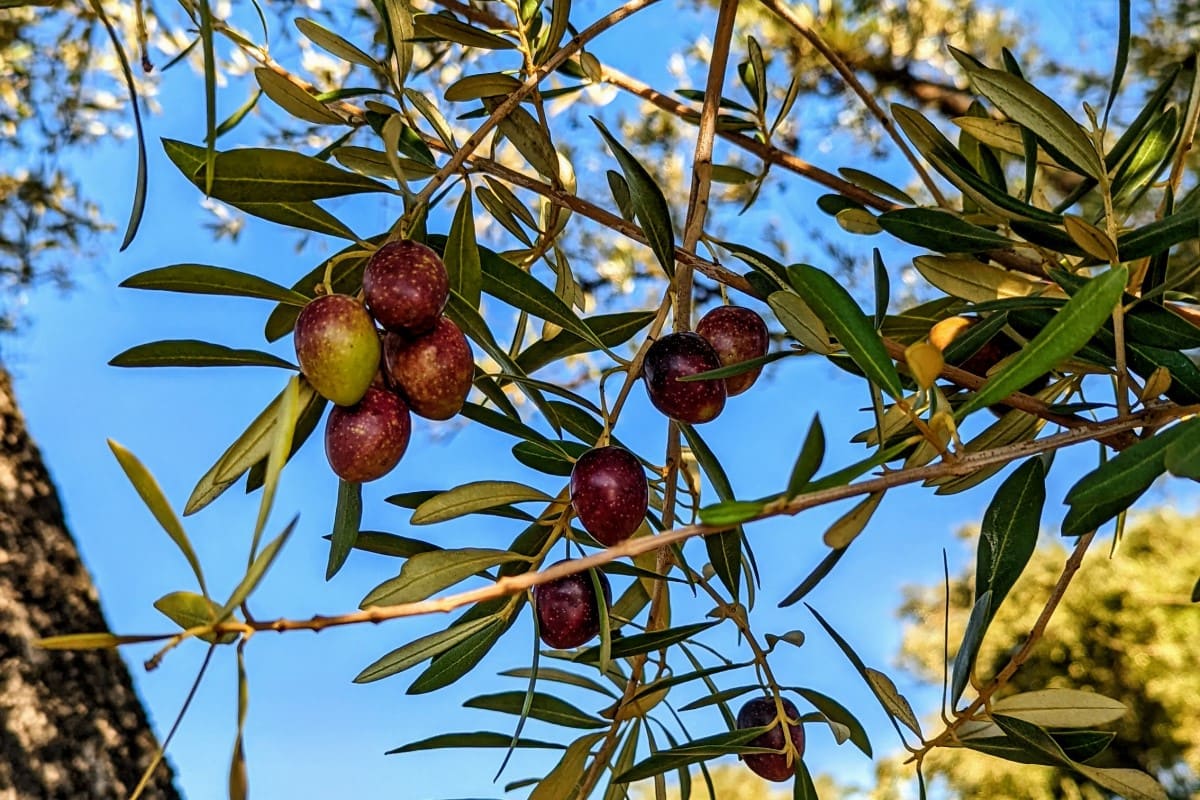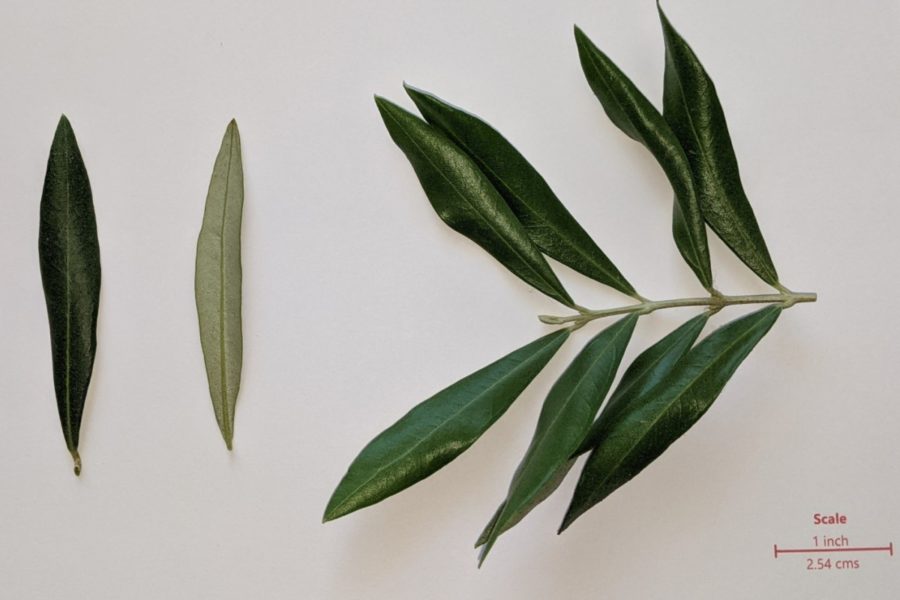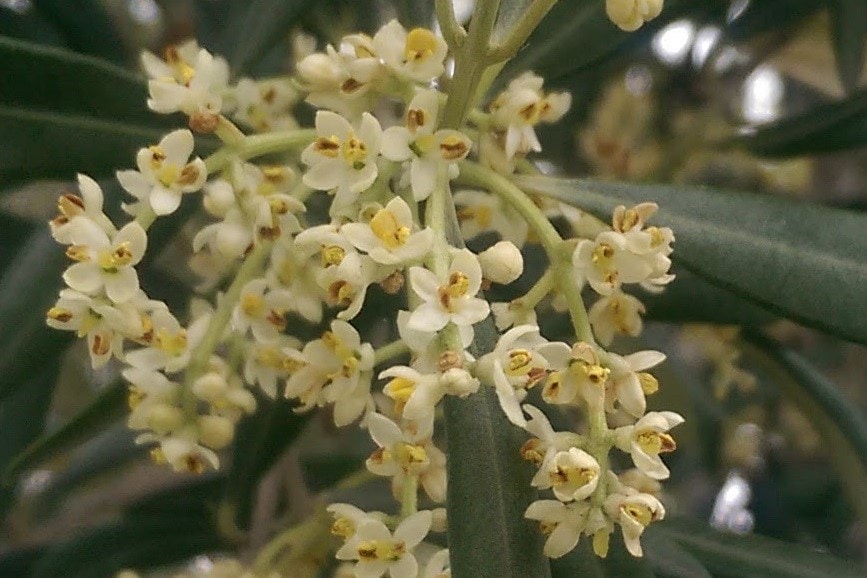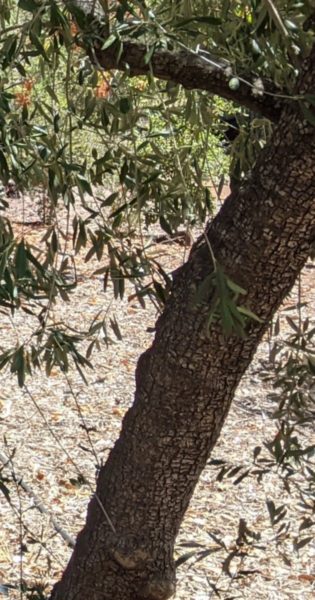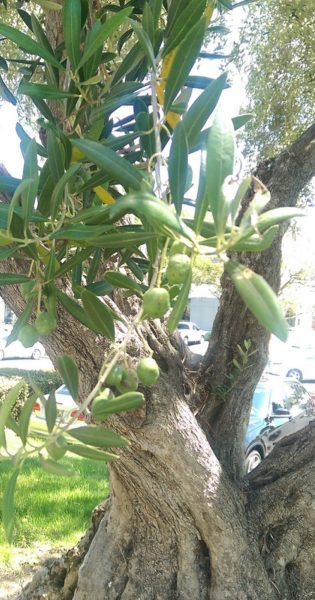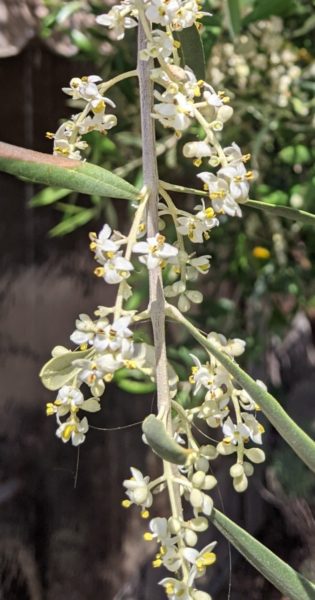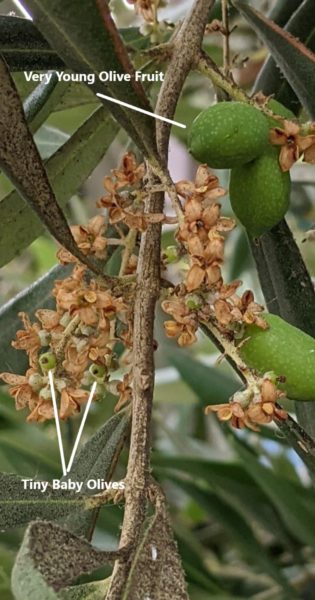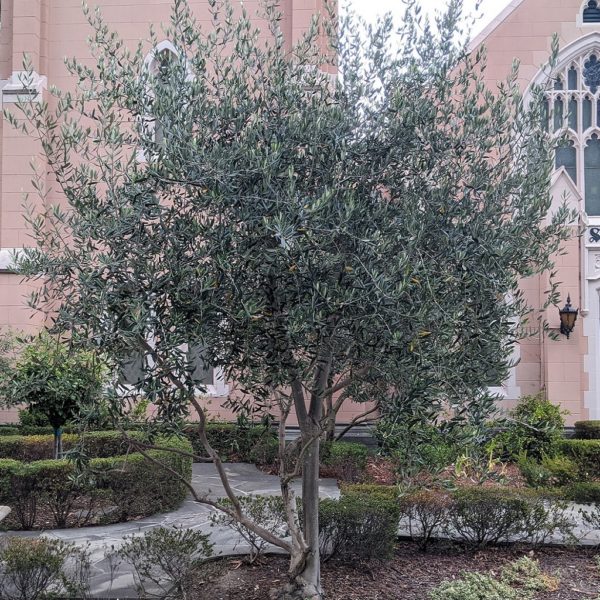In this article, with the help of photos, we will learn about olive tree allergies as well as how and when their pollen spreads.
Olive tree allergy facts and figures
| Olive (Olea Europaea) | Allergy profile |
|---|---|
| Pollen season | Late spring to early summer. In the US: mid-April to mid-June. |
| Pollination type | Primarily wind transported. |
| Cross-reactivities with other pollen | Ash, privet, and lilac. |
| Pollen source | Tiny white, 2mm, flowers with yellow center, which appear during spring (pictures below) |
| Gender | Monoecious: Olive trees generally have perfect flowers with male stamen and female pistil within the same flower. However, staminate (just male) and pistillate (just female) flowers are also possible. |
| Leaves | The narrow, oblong leaves are dark green on one side and light green on the other (pictures below) |
| Fruit | green with white freckles when young. However, it turns fleshy purple or black by autumn. (pictures below) |
How to identify an olive tree (Olea Europaea)?
Olive, a symbol of peace, is a massive irritant for those who suffer from allergies to its pollen. Fortunately, however, it blooms for only four to six weeks in a year, and thus, an allergy sufferer can make peace with it for most of the year. But first, let’s learn to identify olive trees and their pollen-producing habits.
The key features of olive, or Olea Europaea trees are:
- It has oblong leaves, which are generally 5 times longer than they are wide.
- On avearge, the leaves are 3 inches long and 0.6 inches wide (7.5 cm long by 1.5 cm wide).
- Each leaf is uniquely dark green on one side and light green on the other.
- An olive can be a decorative 3 feet tall shrub to a 40 feet tall tree.
- A fully grown tree generally has a twisty and knobby trunk.
- The olive blooms are tiny creamy-white flowers that hang loosely in groups of 10 to 30.
- The young olive fruit is green with tiny white freckles and is the size of a peanut.
In this article, first, we will show you how to identify an olive tree. Then, we will provide useful information about its allergenic pollen.
The leaves
The olive leaves arrange themself in pairs on the twig opposite each other.
The leaves are dark gray-green on one side and light silver-green on the other side.
The leaves are oblong, generally, five times longer than they are wide. The average size is around 3X0.6 inches or 10X1.5cms.
Flowers
The olive tree has tiny white flowers with a yellow center giving them a creamy hue.
The flowers grow in inflorescences of 10 to 30 flowers that hang loosely on the tree.
The flowers bloom in spring.
The yellow anthers in the center of flowers are responsible for releasing pollen.
Fruit
The young baby olive is generally green with tiny white freckles and it starts to appear in June.
The fruit takes four to five months to mature. It changes its color from green to purple to black as it matures by autumn.
Bark and trunk
The olive tree generally has multiple trunks. As the tree gets older the trunk becomes knobby, twisty, and gnarly. Some shrubs and trees may just have one lone straight trunk, but it is not common.
When do olive trees bloom and release pollen?
Generally, olive trees release pollen during the warmer months of the spring usually late April to May in the US. Rarely, if the spring is cooler than usual, the olive may produce pollen a bit later in the month of June.
Depending on the weather conditions, each year the pollen season shifts a little bit. If you live in the San Franicsco Bay Area, you can check the status of local olive pollen season on our pollen counts page.
If you have olive tree allergies, you can also observe the flowering cycles of the plant in your neighborhood and take necessary precautions before pollen actually gets in the air. The flower buds take on average 10 weeks before they open and start releasing pollen.
Three stages of olive bloom
Stage 1: The new flower buds, which generally appear in early March, are a warning signal that pollination is just a few weeks away. Start taking precautions.
Stage 2: The flowers are in full bloom and the tree is actively releasing pollen. This stage lasts four to six weeks sometime mid-April to mid-June.
Stage 3: Flowers wilt and are replaced by fruit. Only 1 to 2% of the flowers produce fruit. The rest die trying. At this stage by the end of June, pretty much all pollen is gone.
What does olive pollen look like and how does it spead?
Even though white and yellow-colored flowers of olive seem attractive enough to be insect-pollinated, they are primarily wind-pollinated. The flowers release their pollen in the air and wind can carry the pollen for many miles.
Pollen is the main reason for olive tree allergies, which are sometimes called hay fever or pollinosis.
The pollen when still on the flower’s anthers is of bright yellow in color, but each grain of it in itself is invisible to the naked eye when airborne.
Olive pollen is about 25 microns (0.025mm) in size, has coarse netting on the surface, and has three furrows with pores. (Olea europaea pollen: Tricolporate with coarse reticulate exine).
Each olive tree is capable of producing hundreds of millions of pollen each spring!
If you live in a region with several microclimates, the risk of exposure to olive pollen could last up to eight weeks. This is because wind can carry pollen from neighboring towns where the olive blooms a bit sooner or later than your own town.
Privet, a close cousin of olive, has somewhat similar-looking flowers and pollen. It is known to cause symptoms for people who are sensitive to olive or ash trees.
Do all olive trees release pollen?
During spring, when olive trees blossom, each tree will have both male and female flower parts on the same tree[6]. The male part of the flower, Stamen, is responsible for releasing pollen. This means all healthy olive trees will produce pollen if they are mature enough to do so. An olive tree generally takes three years to mature before it can produce pollen[2]
Even though some trees may not produce fruit due to environmental stresses or other reasons, they still produce pollen during spring.
How big is a pollen producing olive tree?
An olive tree, that produces pollen, can range from just 3 feet to 40 feet tall. The bigger trees are generally as wide as they are tall. Due to narrow leaves and thin twigs, even the large trees have a “bush” like appearance.
Where do olive trees grow in the US?
An evergreen tree, olive’s origin lies in the eastern Mediterranean. They are now present widely in similar warm or temperate climates of the US. They are quite common in California but are also found in parts of Arizona, Texas, Louisiana, Mississippi, Alabama, Florida, Georgia, South Carolina, southwestern Nevada (Las Vegas), and probably also small portions of southwestern Utah[3].
Olive tree does not grow in cold climates and is not found where winters are long and harsh[4].
Ash tree and Privet are both from the same family as Olive
Ash (Fraxinus), Privet (Ligustrum), and Olive (Olea) are from the same family Oleaceae[R1]. It is possible that if you are allergic to one, you are allergic to the other two [5].
If you have olive tree allergies, you should definitely learn about privet (Ligustrum), which blooms in summer, and Ash tree (Fraxinus), which blooms in winter and spring.
Ash (Fraxinus) on the other hand, blooms before olive. In San Francisco Bay Area, it blooms during February and March.
Final thoughts
If you are allergic to olive pollen and live in a place where the trees are present, it is my hope that armed with the information in this article, you can now identify olive trees and their pollen-producing habits. It will help you make peace with the trees for at least ten months every year. For the remaining two months, you now have the ability to speak with your doctor more intelligently to seek the best care.
Please do read about the oak tree, which releases pollen at the same time as olive. Also, I have written about privet plants, a close cousin of olive, which pollinates after olive.
Sources
- https://en.wikipedia.org/wiki/Olive
- https://www.oliviadaolive.com/olive-tree-flowers-look/
- https://naldc.nal.usda.gov/download/IND23339883/PDF
- https://www.gardenguides.com/131896-olive-tree-leaf-identification.html
- https://pubmed.ncbi.nlm.nih.gov/1471780/
- https://www.intechopen.com/chapters/44150
- https://www.ncbi.nlm.nih.gov/pmc/articles/PMC5342239/
References
- Allergy Plants by Mary Jelks, M.D.
- Plant identification terminology by James G. Harris and Melinda Woolf Harris (Second Edition)
All pictures, unless otherwise credited to another source, are taken by the author. I have studied olive trees and their pollen by doing regular tree inspections and air sampling. The pollen picture is taken in our aerobiology lab using an Olympus compound microscope.

